What Size? Part 2
This is the second of a 2-part primer on how to choose the right size bike. Part-1 was devoted to how we solve this for road bikes. I wrote it this way because once you understand the concept, this all makes a lot of sense. But it's less complex and more easily explained when applied to road bikes. If you haven't read Part-1 I recommend you take a minute to do so, the link to it is just below, at the end of this article.
When we knuckleheads who design and conceive systems to solve bike fit issues wrapped our brains around the superbike problem we had a number of options, but the simplest one was to bypass a lot of what we went through yesterday. Why? Because it's easy to apply a math problem to known values. All road race bikes (with very few exceptions) use standard stems. If I know the length of the stem, and the stem's angle, and an exact number of spacers under the stem, it's easy to calculate the vertical component, and a horizontal component, to a given road bike front end.
So, let's take my own road bike Y and X to the handlebar clamp, which is 625mm and 505mm. Here's what I can do with that, and when you see this process you might ask why everybody doesn't use this process, whether the mechanics for pro cycling teams when setting up bikes for their riders, or bike fitters in shops, or people who just want to go in to test ride a prospective bike and want it set up to match their rider position. Yes, I wonder that. Honestly, I really do.
Let's say I'm a pro rider, and I've just come aboard the Trek Factory Racing team. I want to find out what Trek bike works for me. I go to that calculator referred to yesterday. When I plunk in my numbers (Y of 625mm and X of 505), and the front end I've got on my Cannondale Supersix EVO, you know what the output is already from Part-1 of this article. I'm looking for a bike frame with the following height and length:
Stack = 573
Reach = 396
But Trek doesn't have a bike with that stack and reach. Trek has three geometries, known as H1, H2 and H3. Let's look at the 58cm size of each geometry:
H1: Stack = 567 – Reach = 400
H2: Stack = 596 – Reach = 391
H3: Stack = 611 – Reach = 380
I start hitting the "back" button on my browser, on the page where my calculator sits, typing in different front end configurations until I come up with something that yields, as an output, the stack and reach of one of these Trek geometries above. The H3 geometry is not long enough, and is too tall. So I can "flatten" the front end by putting a minus-17° stem on the bike (versus the minus-6° that I have on my Supersix), and I can make up for the H3's frame "shortness" by lengthening the stem. But, even with a 130mm stem, angled at -17°, and only a 5mm headset dust cover, I'd need the following frame:
Stack = 611
Reach = 382
That H3 geometry is just too "Gran Fondo" for me. I can't get the bars low enough regardless of what stem/spacer combo I try (the head tube terminates too high above the bottom bracket) and I can't get the bike long enough, unless I put on a 140mm stem, and even then it's a few millimeters short.
H1 is on the other end. This is a Goldilocks and 3 Bears thing. The frame geometry is too low for me, and too long. I'm going to have to make the whole complex taller, and less long, by manipulating the stem and spacers. Let's start just with spacers. If I take that front end I've got on the Cannondale and just add an extra 10mm of spacers (20mm total), I'm now looking for the following frame:
Stack = 564
Reach = 399
Very close. So I can ride that H1 geometry. While the H3 was just too far away from what I ride to make it work, the H1, while a bit away from what I ride, is still usable.
But I can also ride Trek's H2 geometry, and I would do that just by, of course, manipulating the front end. But why do this in the shop, putting stems on and taking them off, measuring? Very time consuming! Why not do this virtually, using a calculator like the one on Slowtwitch? Much quicker.
Trek's H2 geometry is taller than the Supersix geometry, so, instead of a –6° stem I put on a –17° stem, which has a stem extension parallel to the ground. This makes room for the H2's taller geometry. If I want to "find" a bike yielding my rider position, and I'm looking for a bike frame geometry underneath a 120mm stem, angled at -17°, with 10mm total of headset dust cover and spacers, I'm looking for this geometry:
H2: Stack = 596 – Reach = 394
Almost a dead-on match with H2. And this is what I'd prefer, because I'd rather not have a big vertical component to my front end. I'd rather have frame take up most of that space. The vertical distance between the top of the frame's head tube and the center of the handlebar clamp is only about 30mm with the H2, and 60mm with the H1. Is either bike rideable? Yes. Is one bike materially better than the other for me? Debatable. Personal preference. Plus, maybe some other considerations. This process when applied to a small-statured rider might turn on other imperatives, like standover height. Maybe the lower frame geometry with taller front end is desired if extra standover height is needed.
The point is that this process above can be used for any frame, any bike, any contemplated front end, in the world of road bike riding. And that's because a stem is a stem. A spacer is a spacer. It's just a math problem. This even works for tri bikes, as long as they use standard stems.
Not so for triathlon superbikes. There's no 120mm or 90mm stem for a Speed Concept. There's no –6° or –17° stem pitch for a Scott Plasma Premium, or a Cervelo P5 Six. The calculator on Slowtwitch that makes the process so easy for road bikes can't be used for superbikes.
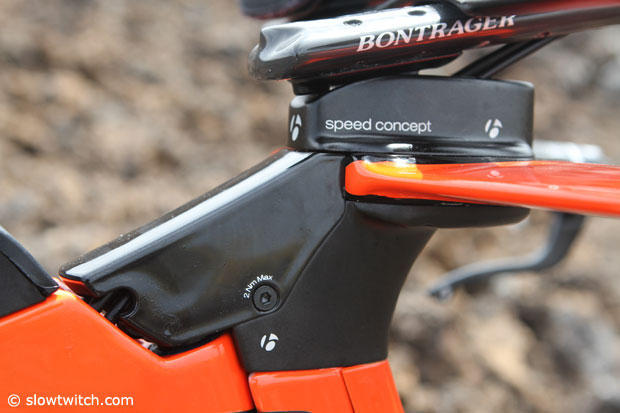
So we reluctantly bypass this process above entirely, and in its place we just measure your Y and X distances from the bottom bracket to the armrest, and then each bike company gives you its own prescription via its own system (I spent last week walking you through these systems, bike company by bike company, the links to these articles are just below this article).
Remember how in Part-1 I could have fit aboard either a 56cm, 58cm, or 60cm Supersix EVO, just by making the front end longer and taller as the frame got smaller; or by making the front end (stem length and pitch, and spacers) shorter and flatter as the frame size got larger? Same thing with these superbikes.
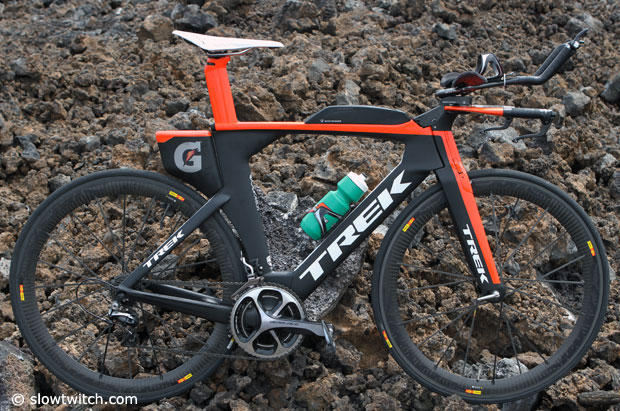
Look at the images above. This is a Speed Concept owned by Chris Legh. Note that for this bike the front end uses a "stem" (what passes for a stem in the Speed Concept) that is tall, and it is long. The SC has 6 available stems: two lengths, three heights. What you're looking at here is a pretty tall stem, and a pretty long stem. And a pedestal on top of it all as well. Furthermore, the pads are pushed out pretty far. Same thing with Rebecca Keat's Speed Concept in the 2 images below.
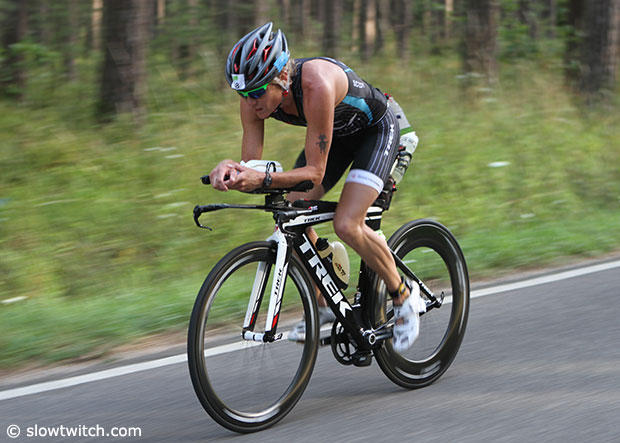
I think for Chris's bike, and maybe from Rebecca's as well, one could make the case that a larger frame size could have easily been chosen. In this case, more frame would have filled up that space, and less front end. You use a frame the next size up, and a stem that's less long and less tall. It's analogous to me riding a 56cm road bike with a 130mm stem pitched up, and with spacers under the stem, versus riding a 58cm road bike with a 120mm stem, angled flatter, with fewer spacers.
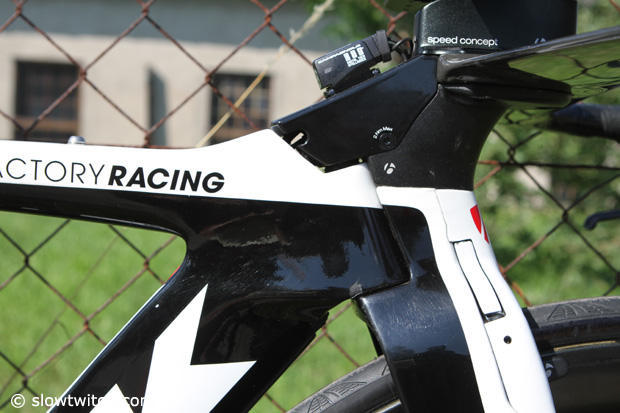
Dirk Bockel's Speed Concept (below) probably could have been a size smaller than it is, most likely. If so, it would have had a front end that looks more like the one on Chris Legh's bike. Dirk's bike has the lowest of the 3 stem heights that Trek offers for its Speed Concept.
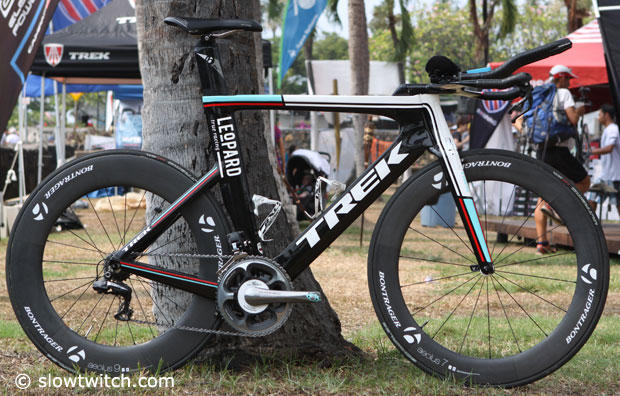
Meanwhile, pro cyclist Matthew Busch (below) has a nice position, bike looks good, but it's pads are quite a bit above and out in front of the frame. He also could have opted for one size up. But it would have brought his pursuit bars up accordingly, and this smaller bike, pedestaled, might be more aerodynamic than a larger frame size unpedestaled (I don't know).
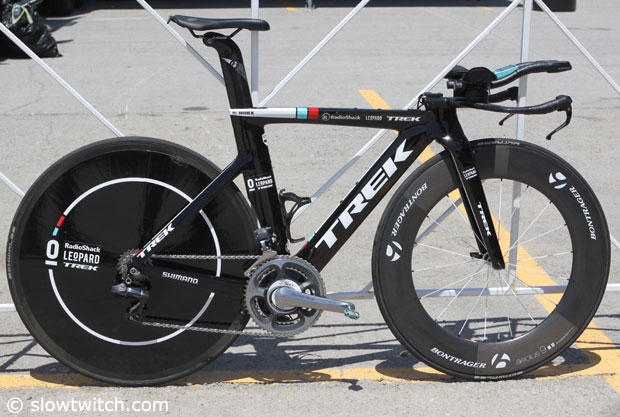
I'm not arguing that any of these frame sizes is wrong for the athletes riding them, rather this explains how, when you look at a Cervelo, Felt, Trek superbike sizing chart, you can either be a M or a L, or a L or an XL. It just depends on what front end you stick on that bike. This is why, when you look at Trek's chart for its Speed Concept, there are 2 or even 3 sizes you could choose. You either opt for less frame and more front end (stem length, stem height, and pedestal), or you opt for more frame and less front end. What should you choose?
Weight Displacement
The higher you sit off the ground (saddle height) and the more forward you sit (the steeper your seat angle; or the more forward your saddle position versus the bottom bracket), the more front/center your bike needs in order to give you a good base of support. A bike's front/center is (remember Part-1 of this series) the distance from the bottom bracket (where the crank attaches to the bike) to the front wheel axle. How much front/center do you need? For tri?
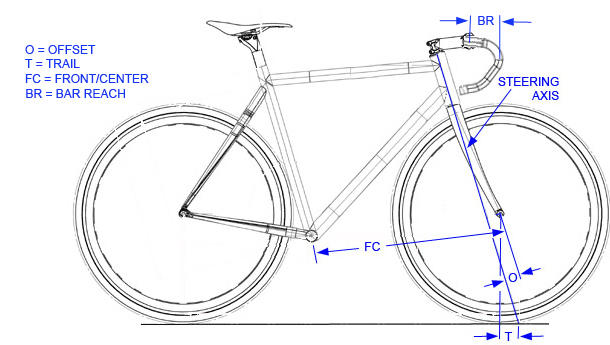
Below is a very rough guesstimate, and this might be the first you've seen anything like this because I don't remember anyone expressed anything like this before in writing.
The first number expresses, in centimeters, two values. First, it's saddle height. And we're talking about the distance from the BB to the top of the saddle, midway between tip and tail. It also expresses the distance from the bottom bracket forward, just in the X axis (length), to the center of your hand as it grips the aerobar extensions. How does one number reflect two values? Because those values are very often very close to each other.
Me, I'm a little but more torso than I am leg, so, that distance from the BB to the center of my hand when I'm in the aero position is about 80cm but my tri bike saddle height is just 78.5cm. Our chief technology officer here at Slowtwitch, Jordan Rapp, is the opposite. He's got about the same BB=>hand length as I do, or maybe even slightly less, but his saddle height is 82.5cm. He's more leggy. I'm more torsoey.
Part of the determiner of whether your BB=>hand hold is greater or lesser than your saddle height is morphology. Part of it is how steep you ride: The further forward your saddle, the more the front of the bike is projected in front of the BB. But, for average people, here is a pretty good gauge, where if your saddle height is about 76cm, and your BB=>hand center = 76cm, the front center of your bike ought to be, very roughly, in the neighborhood of 610mm. Or 61cm, if you want to keep it all in one unit of measure. Here it is scaled, and remember, this is only for tri:
86cm => 660mm
84cm => 650mm
82cm => 640mm
80cm => 630mm
78cm => 620mm
76cm => 610mm
74cm => 600mm
72cm => 590mm
70cm => 580mm
68cm => 570mm
66cm => 560mm
64cm => 570mm
Please don't make too much of this! Me, I can ride, and have ridden, bikes with front/center measures between 612mm and 650mm. They all worked fine. I think about 625mm or 630mm is where I like it. The bikes in this front/center range handle very well for me. When I get less than 610mm I tend to have an awful lot of weight on the front wheel when in the aero position, as in, more than 65%. I'd rather keep that in the range of 55% to 60%. When the front/center gets long the bike can sometimes feel unwieldy, not spry enough, and I have to muscle the bike to turn it.
Pursuit Bar Position
With some of these bike options you are in between long and short stems. Me, on a Speed Concept I've got to pull the armrests back a bit on a low/far stem, and I've got to push the armrests out a bit on a low/near stem. That's because these stems are 50mm apart in their lengths. What do I choose? What's the difference?
In the first Speed Concept I rode (when it first came out in 2011) I chose the low/far stem because I literally had no room for all the wiring and harness of the Shimano electronic system if I chose a low/near stem. But the longer stem pushed the pursuit bars out in front of the bike quite a bit. Had I chosen the “near" stem everything would have remained the same height, but the pursuits would have come back toward the bike 50mm (which is a lot). I think when you see some of these Trek athletes riding "near" stems it's because they want the pursuits pulled back.
The placement of the pursuit bars sometimes informs the frame size or front-end config you buy for these superbikes. With some of these bikes there is only one stem option. All the height, per frame size, is achieved through pedestals, and the length of your aerobar pad position is achieved through pushing the extensions out or pulling them back (with the armrests along for the ride, since they are usually bolted to the extensions). On superbikes with only one available stem size the larger frame size will push the extensions further in front of, and raise the pursuits higher than, the BB in the exact amount the frame increases in stack and reach. If you want the pursuits lower, and closer in, choose the smaller size, and just pedestal the pads and push the front end out. If you want them higher and further away from the BB choose the larger size and pedestal the pads less.
Of course, pursuit position might not be the driver for you. Maybe the front/center is the driver. Maybe you want a more stable support underneath you. Or, it's a mix. This is my case with the Speed Concept. I can ride an XL with a low/near stem and a 15mm pedestal. I can ride a size M in this bike with a medium/far stem. Or I can split the difference and ride a size L, with a low/far stem, 45mm pedestal. This gives me the front/center I want, the steering I want, the pursuit position I want, it's an all around good choice.
Stem Lengths
Funny thing about tri bikes: it's hard to err on the side of a stem too short. We steer differently on tri bike than on road bikes. We tend to steer with, or from, the middle of our bodies. I don't know how else better to describe it. We lead with our body weight. We lean into every turn or correction left and right. We do very little steering with our hands, that is, our hands do make adjustments when we're in the aero position, but they adjust to a turn already first executed by a change in our body lean.
Yes, we also turn with our body weight in road cycling as well, but the steering lever seems to need or want to be longer on a road bike. When we're in the aero position this isn't a necessity and, indeed, a longer steering lever probably means a shorter front/center, and we're always looking for more front/center on a tri bike than on our same corresponding road bike.
If you look at the actual geometry, in X and Y dimensions, of some of these custom stems made by Felt, Trek and others, they can be very truncated in length (narrow) and tall. Or seem to be. Or would be were stems of this geometry placed on a road bike. But they're not so scary when they're on tri bikes. I have seen pad centers on tri bikes that are so far back they are actually even with the steering axis (the projection up and down through the fork steer column). I don't like this, but not for the reason you think. It's not that these bikes are unrideable. Rather, that pads pulled this far back almost always mean the bike is very long, and that almost always means the pursuit bars are going to be waaaay out there, so that when your hands are in the pursuits you've got a lot of weight on the front of the bike when you're cornering, descending, braking. There's no way in heck you can climb comfortably and powerfully with your hands way out there.
Short stems on tri bikes are fine. Short X dimensions from the steering axis to the centerline of the pursuit bar is okay. Short X dimensions from the head tube top or steering axis to the pad center is okay. Just take a look at everything when you choose from among a lot of superbike size and front-end options: bear in mind where the pursuits are going to be, that the bike's front center is not too far away from optimal.
The Take-Away
When you reach forward with your hands and grab the handlebars, or lay your elbows down in the cups, the handlebars or cups got to where they got because a number of sub-assemblies were bolted, slid through, slid over, screwed down, that created an entire assembly. Those sub-assemblies are like Tinker Toys, or an Erector Set. The frame can be low or tall, long or short. If the frame doesn't project out far enough, get a longer stem. If it's not tall enough, spacer it. Or pitch the stem up. It's all just a compendium of parts that get you to the same position, just as this simplistic rendition of a road frame + spacers + stem. (In this very simple and not very precise drawing, these are two frames a size apart in the size run, but each can be used to achieve the same position for a rider through mating the frame with a front end that is either taller and longer, or less tall and less long.)
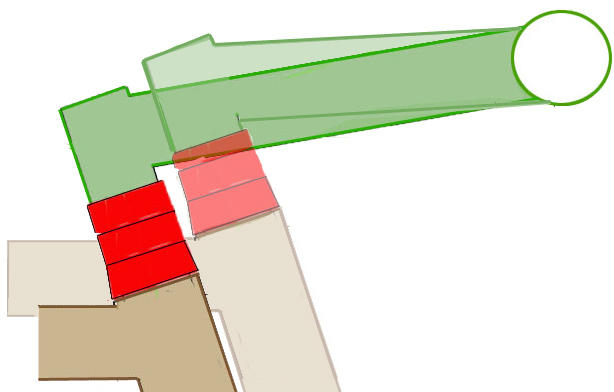
It's the same principle with our space-age triathlon superbikes, it's just that the front ends on these superbikes are more exotic looking. Just remember that it's not that it makes no difference what frame + front end you choose. It just makes no difference to the fit what frame + front end you choose. But if you choose a smaller frame, and you attach to it a taller and longer front end, you might end up with a bike that offers a smaller base of support (not enough front/center).
But that doesn't automatically mean choose the larger frame. If you choose a larger frame size in a P5 Six, with a low 3T Aduro stem, your pursuit bars will sit higher. If you choose a smaller P5 Six frame size with a High-V Aduro stem, that High-V makes up for the lowness of the smaller frame, but the pursuit bar will stay low, only the pads and extensions will raise up. So, do you want the lower pursuit position, and does the smaller size offer enough front/center? Get the smaller size P5. Do you want a higher pursuit position? Get the larger frame size.
Whenever these Pad X/Y systems from Trek, Felt, Cervelo, BMC and others offer you more than one frame size option, it's because there is more than one configuration capable of getting you into your precise position once you're in the aerobars. The difference is in the way the bike will handle, and in where the pursuit bar will be positioned in space when you're not in the aero position. And in the positional changes available to you if your position changes (were to choose the SC in the XL size I'm bottomed out – I can fit on that bike, but not if I ever want to lower my aerobars). And, there might be differences in the aerodynamics between one Trek, Cervelo et al, configuration or another, though I think the jury is still out on whether the larger or smaller frame size is more aero, and that's also going to change depending on the specific bike in question.



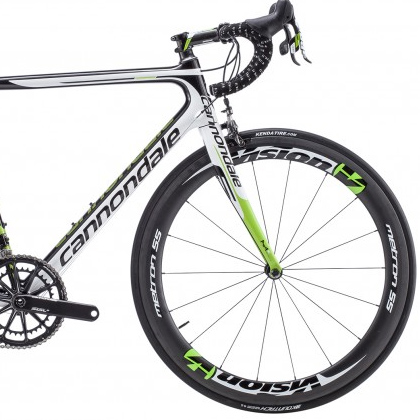
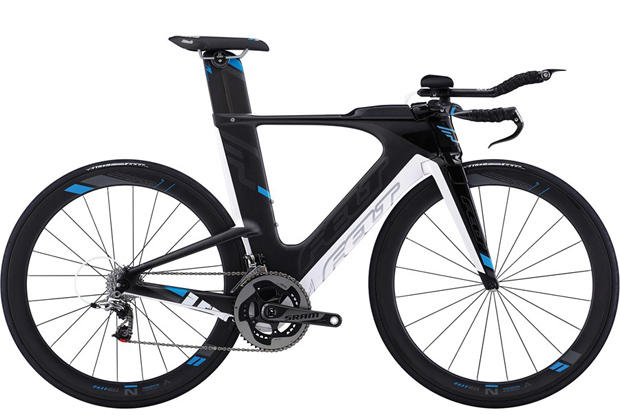
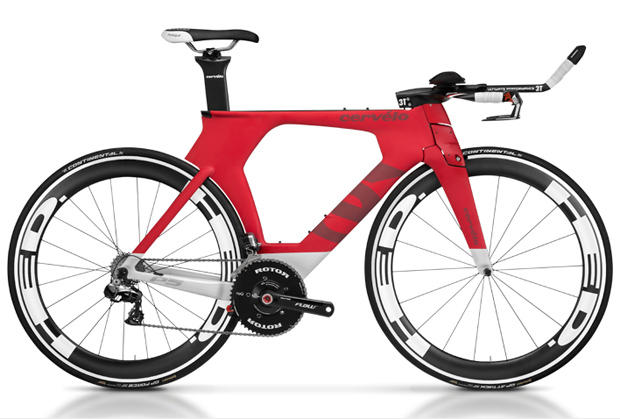
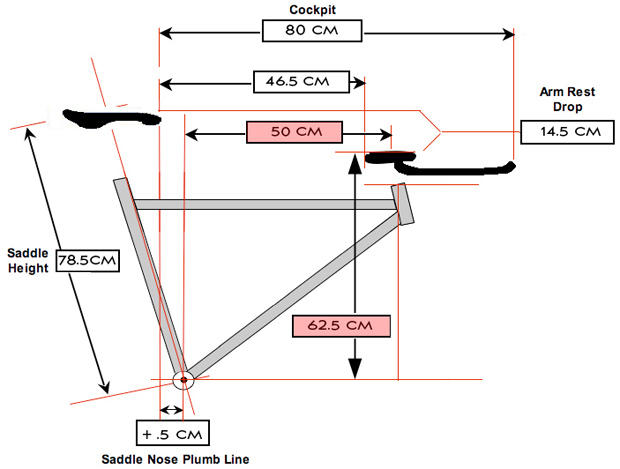
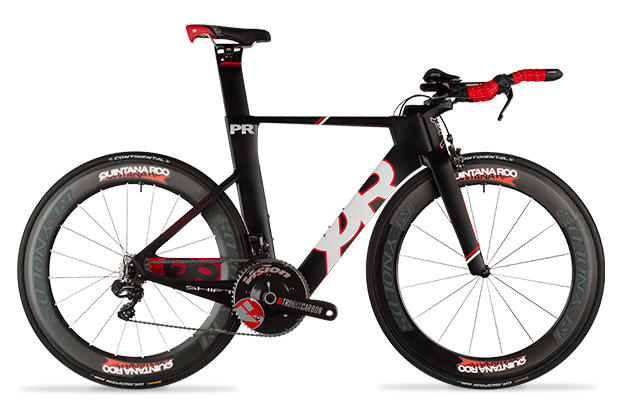

Start the discussion at forum.slowtwitch.com